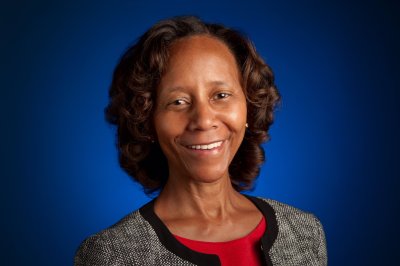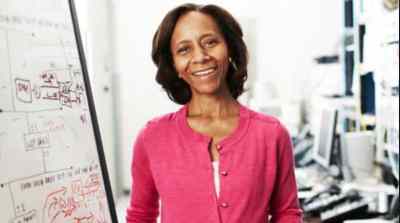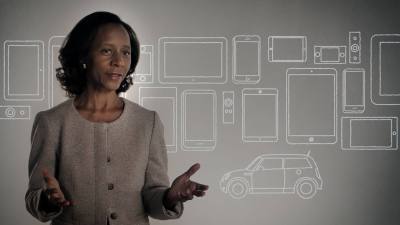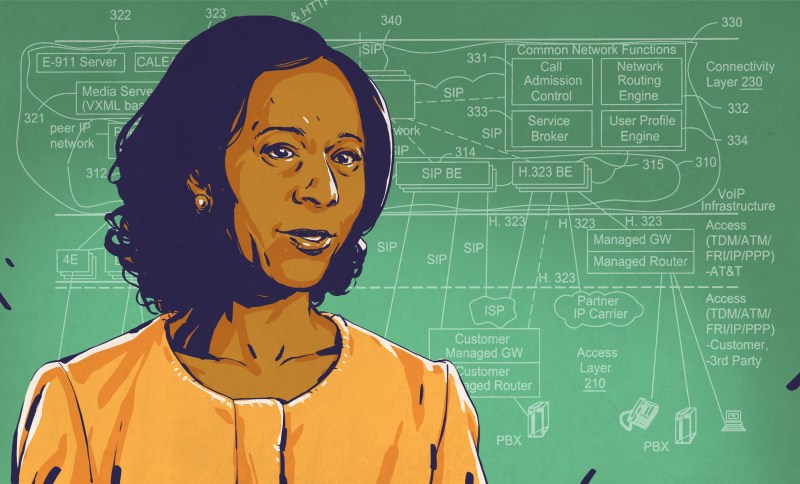If you’ve ever used FaceTime, Skype, own a Magic Jack, or have donated money after a disaster by sending a text message, then you have Marian Croak to thank. Her leadership and forward thinking changed how Ma Bell used its reach and made all of these things possible.
Marian Croak is a soft-spoken woman and a self-described non-talker, but her actions spoke loudly in support of Internet Protocol (IP) as the future of communication. Humans are always looking for the next best communication medium, the fastest path to understanding each other clearly. We are still making phone calls today, but voice has been joined by text and video as the next best thing to being there. All of it is riding on a versatile network strongly rooted in Marian’s work.

Little Miss Fix-it
Most kids, girls especially, want to help Mom and Dad at some point in their childhoods. But young Marian wasn’t interested in learning to cook or do the laundry — she wanted to be the one her mother called on when the furnace quit working or the dishwasher started leaking. Whenever a repairman came to the house, Marian would follow close behind, bugging them with questions about their equipment and troubleshooting procedures.
Other 1960s households might have discouraged that behavior, but Marian had a lot of support from her family, especially her father. She even quit Catholic school in 10th grade to chase a more scientific education in a gritty NYC public high school with bars on the windows. Marian’s parents weren’t pleased, but they didn’t try to stop her. In fact, her Dad showed his support by building a chemistry set in the basement. After graduation, Marian went to Princeton and then moved across the country to USC for graduate school. There, she earned a PhD in quantitative analysis — now known as data science — and social psychology.
Pulling Ma Bell Into the Internet Age
Marian accepted a position at Bell Labs in 1982 and moved back to the east coast before her USC graduation cap hit the ground. While most of the company was focused on voice, Marian worked on messaging applications and was tasked with finding out whether already-deployed messaging applications were compatible with each other.

By the early 1990s, Marian moved into data services and networking. These were both due for a new infrastructure, and AT&T was planning a multi-billion dollar switch over to the Asynchronous Transfer Mode (ATM) protocol. Marian and her team started looking at TCP/IP instead, and believed it was the wave of the future. They advocated for the protocol and convinced the executives that IP was the way to go, even though the technology wasn’t quite ready for the proposed load of integrated voice, data, and video.
AT&T merged the IP and voice networking engineering teams and assigned Marian to manage this group of 2,000 or so engineers in order to get the network ready. Because of her background, Marian was in a unique position to understand both the plight of the fast-to-market IP engineers as well as the slow and steady, test-happy approach of the networking side. But Marian wasn’t some hands-off VP — she was down in the trenches by day, night, and weekends. By the end of Marian’s 32-year career with AT&T, she had racked up over 200 patents, more than half of which are related to Voice over IP (VoIP) products.
Vote with Your Phone
In the early 2000s, text messaging was in its infancy and ruled by T9 input — using the numeric keypad on the phone to spell out messages, often through [leveraging a predictive algorithm to avoid] repeated presses to select each letter. Still, Marian saw the potential in the service. AT&T partnered with American Idol to create a text-based voting system built by Marian’s team. Millions of people learned how to text so they could weigh in each week.

When Hurricane Katrina hit the Gulf Coast in 2005, Marian saw even more potential and created a platform for people to donate to the relief fund by texting, essentially authorizing a bit extra on next month’s phone bill. Text to donate was used again to great success to provide relief for Haiti after the 2010 earthquake.
Marian was hired by Google in 2014 and is currently a Vice President of Engineering. Today, she leads the charge of expanding internet access in developing countries. She continues with her humanitarian work, having led Project Loon’s initiative to provide balloon-based emergency cell service to the residents of Puerto Rico following the devastation of Hurricane Maria.
In many ways, she is still doing the same thing she has done throughout her career — ‘trying to change the world in simple, pragmatic ways’, as she put it in a 2012 letter she wrote to young women in technology. Marian continues to be an inspiration. You can watch her keynote address below from Google’s 2017 Women Techmakers Mountain View Summit.
















Back in the early 90s, my employer was renting T-1 lines for about ~$1K/month, and fractional for a bit less.
i guess I was under the impression that TCP/IP had been around since the dawn of Ethernet…
Ethernet and TCP/IP coexisted for several years before TCP/IP first ran on top of Ethernet. Even then, there were at least three implementations of the layer-2 to layer 3 abstraction that didn’t interoperate. (Not including the various Ethernet frame formats, sigh.)
It took a while for things to settle down, for de-facto standards to crystalize out of the mess, and for TCP/IP standardized on Ethernet. It was mostly a done deal by 93, but there were still ways to screw it up if you tried. Or if your vendors wanted to lock you in.
Even today non-TCP/IP ethernet is used in audio recording; each channel gets an arranged timeslice. There are no collisions or addresses.
Funny but TCP/IP was never tied to Ethernet I am pretty sure that it existed before Ethernet. And lots of protocals ran on Ethernet including IPX/SPX from Novell and goodness knows what else. It is funny but I remember reading some article about networking back in the late 80s discussing networking protocals and in it said that “popularity should not drive the choice of a standard if we did that we would just make TCP/IP the standard because of all the big iron on DARPANET using it, and no one wants that.” Well I guess they where wrong. You have to also understand that DHCP did not exist at that time so you had to manually give every machine and ip address while IPX/SPX was more automatic and frankly no one was thinking of normal people connecting to DARPANET.
The need for something like TCP/IP was driven out of a study from the RAND Corporation(1960s). We needed a packet network that would allow traffic to reroute around telecom infrastructure that was destroyed in an attack(USSR). In those days, computers were connected in a point to point fashion until Ethernet, Token Ring and other LAN technologies arrived. The TCP(unlike UDP) protocol itself had/has capabilities for end to end connection oriented communications i.e did my packet get there. Lots of overhead. I wonder what the TCP/IP replacement protocol would look like if we had a chance to do it all over again now? I’m happy I had a chance to work on the networking side as these standards evolved and fell by the wayside to TCP/IP. (OSI, DECnet, TCP/IP, AppleTalk, Novell, etc…..) Kind Regards….
sigh.. here we go again. This article is reads like a eulogy or obituary.
Shall we all agree that a successful career may involve aspects of hacking but describing such a career does not describe a hack?
I’ve always found these mini bios really interesting. If you’re not liking it, you could just scroll past instead of complaining.
Same here, I really like these articles. All my life I grew up reading about scientists who’s inventions have changed our life profoundly (Edison, Bell, Fleming etc) however they all were gone long ago. It’s refreshing to read about great inventors of this era, who are still alive and making a difference.
Humanity has a tendency of acknowledging your contribution truly once you’re gone – but it’s too late by then.
Humaans! All that talking about other Humaans. I thought this place was for talking about the Rules of Acquisition?!?!?
“she had racked up over 200 patents, more than half of which are related to Voice over IP (VoIP) products.”
Software patents need to go.
patents are good because then the rest of us can figure out different (and perhaps better) ways to do things.
Or sometimes we don’t and whole world has to wait for the patents to expire to continue it’s natural course, like it happened with 3d printing. Not to mention all the patent trolls, being extremely harmful to the open source community, like the one who sue open source project like gnome. Software and all vague/generic patents are
purely evil and should not be
“AT&T was planning a multi-billion dollar switch over to the Asynchronous Transfer Mode (ATM) protocol. Marian and her team started looking at TCP/IP instead […]”
Now this was forward-looking. In a world ruled by time division multiplex and caught in the iron grip of the CCITT (later ITU) mega-stack, and herself in the eye of the hurricane (ex-Ma-Bell), I can only guess how much courage and stamina this lady has.
AT&T was not nearly a leader in VOIP. Start up carriers (CLECs) used VOIP to escape the ridiculous Incumbant TDM charges and AT&T eventually had to accept that it was more efficient transport. They were very late to the party.
What is MVP??? This is the only who author always uses references don’t abbreviations I don’t know.
Most valuable person/player
Yep – it’s an Americanism I think. Not really widely understood in lots of other English-speaking territories. (I think it stems from American sports like American Football, Baseball, Basketball etc.?)
Yup that’s exactly it
Is the author aware that many readers are not American? It’s the second time she uses a reference only Americans get. Very silly!
I’d take it more seriously if the complainers restricted themselves to talking about the need to introduce acronyms, instead of fretting about Americans.
And honestly, if 10 people make this complaint, at least 9 of them have in fact actually heard the term before, they just pretend they haven’t, because prejudiced.
IIRC, T9 specifics refers to the auto-correct style of using a number pad to enter words with only one key press each.
Looks like you’re right. That was my fault in editing. I’ve made an update to the article, thanks!
Did she………..uh…………………Croak?